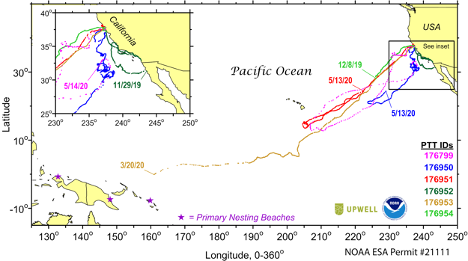Data collected at nesting beaches give us only a brief glimpse into sea turtles’ intricate life histories. Upwell strives to provide the best available information and protections where turtles spend most of their lives: in the ocean. We broaden understanding of sea turtles’ complex life histories and foraging ecology by expanding in-water research.
Satellite tags are one of the best tools available to collect data on sea turtle movements and behaviors in marine habitats. But where tags are deployed matters. Deploying tags at nesting beaches means we are limiting our research scope to the females within a population that are nesting in a given year. Moreover, it can skew data points toward inter-nesting and post-nesting movements and behaviors exhibited by these females during the relatively short period when the satellite tag is active.
To collect data on foraging behavior, scientists must deploy tags in foraging habitats. So, why don't we see more satellite tag deployments in foraging zones rather than nesting beaches? Well, it's challenging and expensive. Whereas the turtles come to researchers at nesting beaches, researchers must seek out turtles in foraging habitats. Sometimes, in our partnership with NOAA to capture and tag leatherbacks in the California Current, this can feel like finding a needle in a haystack. So how do we do it?
Tagging leatherbacks in foraging habitat requires highly trained marine observers working from aerial survey planes to spot turtles in the water as well as research vessels to safely capture and tag them under the supervision of wildlife veterinarians. The additional costs of contracting specialized veterinarians and trained observers, along with chartering research vessels and aircraft, make monitoring leatherbacks in foraging habitats much more expensive than nesting beach monitoring programs, which can be staffed mostly by volunteers conducting censuses on foot.
Moss Landing Marine Labs’ specialized research vessel Sheila B. in leatherback foraging habitat abundant with sea nettles for Upwell-NOAA research (Karin Forney / NOAA permit #21111)
Upwell remains undeterred. We are dedicated to overcoming barriers to collecting data on turtles in foraging habitats because we have seen, alongside our project partners at NOAA, how important it is to study turtles at sea. Since 2018, Upwell and NOAA have jointly deployed satellite tags on seven West Pacific leatherbacks in the California Current. We have monitored their movements and behaviors in critical habitat zones off California and tracked their migrations across the Pacific. This is the only project that captures and tags foraging leatherbacks in the entire Pacific Ocean.
A major aspect of Upwell and NOAA’s research is data sharing; our findings are made available to state agencies and fisheries managers. The data gathered from satellite tracking and aerial surveys are informing the Dungeness crab fishery about risks of leatherback bycatch and the potential for fishery closure in the case of mortality. When provided with real-time data on when and where leatherbacks are present in California waters, fisheries managers and fishers are better equipped to proactively reduce bycatch, avoid closures and assist efforts to recover critically endangered West Pacific leatherbacks.
Map: Tracking data from six leatherbacks tagged in California Current in 2019



